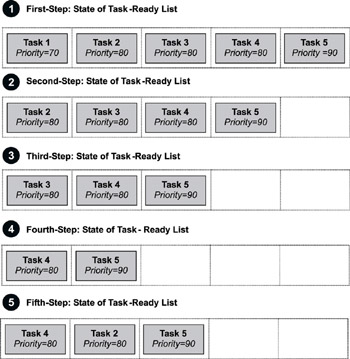Книга: Real-Time Concepts for Embedded Systems
5.3.1 Ready State
5.3.1 Ready State
When a task is first created and made ready to run, the kernel puts it into the ready state. In this state, the task actively competes with all other ready tasks for the processor's execution time. As Figure 5.2 shows, tasks in the ready state cannot move directly to the blocked state. A task first needs to run so it can make a blocking call, which is a call to a function that cannot immediately run to completion, thus putting the task in the blocked state. Ready tasks, therefore, can only move to the running state. Because many tasks might be in the ready state, the kernel's scheduler uses the priority of each task to determine which task to move to the running state.
For a kernel that supports only one task per priority level, the scheduling algorithm is straightforward-the highest priority task that is ready runs next. In this implementation, the kernel limits the number of tasks in an application to the number of priority levels.
However, most kernels support more than one task per priority level, allowing many more tasks in an application. In this case, the scheduling algorithm is more complicated and involves maintaining a task-ready list. Some kernels maintain a separate task-ready list for each priority level; others have one combined list.
Figure 5.3 illustrates, in a five-step scenario, how a kernel scheduler might use a task-ready list to move tasks from the ready state to the running state. This example assumes a single-processor system and a priority-based preemptive scheduling algorithm in which 255 is the lowest priority and 0 is the highest. Note that for simplicity this example does not show system tasks, such as the idle task.

Figure 5.3: Five steps showing the way a task-ready list works.
In this example, tasks 1, 2, 3, 4, and 5 are ready to run, and the kernel queues them by priority in a task-ready list. Task 1 is the highest priority task (70); tasks 2, 3, and 4 are at the next-highest priority level (80); and task 5 is the lowest priority (90). The following steps explains how a kernel might use the task-ready list to move tasks to and from the ready state:
1. Tasks 1, 2, 3, 4, and 5 are ready to run and are waiting in the task-ready list.
2. Because task 1 has the highest priority (70), it is the first task ready to run. If nothing higher is running, the kernel removes task 1 from the ready list and moves it to the running state.
3. During execution, task 1 makes a blocking call. As a result, the kernel moves task 1 to the blocked state; takes task 2, which is first in the list of the next-highest priority tasks (80), off the ready list; and moves task 2 to the running state.
4. Next, task 2 makes a blocking call. The kernel moves task 2 to the blocked state; takes task 3, which is next in line of the priority 80 tasks, off the ready list; and moves task 3 to the running state.
5. As task 3 runs, frees the resource that task 2 requested. The kernel returns task 2 to the ready state and inserts it at the end of the list of tasks ready to run at priority level 80. Task 3 continues as the currently running task.
Although not illustrated here, if task 1 became unblocked at this point in the scenario, the kernel would move task 1 to the running state because its priority is higher than the currently running task (task 3). As with task 2 earlier, task 3 at this point would be moved to the ready state and inserted after task 2 (same priority of 80) and before task 5 (next priority of 90).
- State match
- 5.3 Task States and Scheduling
- 5.3.2 Running State
- Chapter 7. The state machine
- User-land states
- State NEW packets but no SYN bit set
- Конкурентный бенчмаркинг в GE Real Estate
- Свойство WindowsState
- Conditional Statements
- Special Statements: for, while, and Others
- The for Statement
- The while Statement




